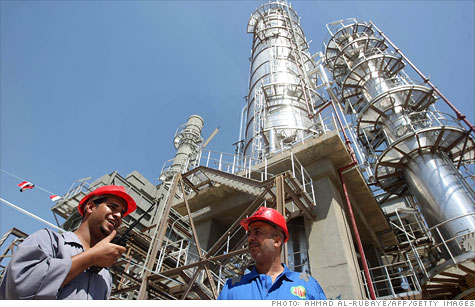Search News

After years of stagnant production, Iraq oil output is starting to increase.
NEW YORK (CNNMoney) -- As the last remaining U.S. troops leave Iraq, oil production from the war-torn but oil rich nation is finally starting to ramp up.
Oil production in Iraq hovered around 2 million barrels a day for much of the post-U.S. invasion period.
But over the last year production jumped 13%, going from 2.3 to 2.6 million barrels a day, according to the U.S. Energy Information Administration. Much of that increase has come in the last few months alone, and it's part of the reason why many analyst expect Saudi Arabia to soon cut oil output.
In fact, some analysts say that over the next few years Iraqi oil production could really balloon. The Iraqis may eventually produce as much oil as the Saudis.
But an increase in Iraqi oil production raises several issues, including what impact it may have on world oil prices and how all that oil money will get divided up.
A massive amount of oil: It's no secret that Iraq has a huge amount of oil in the ground. EIA estimates the country has the world's fourth-largest proven oil reserves, and even more may lie under the unexplored western desert.
A couple of years ago, the newly formed Iraqi government began awarding big contracts to the world's major oil companies in an effort to boost its nascent production.
The companies they selected came from all over the world -- including from all five permanent members of the United Nation's Security Council.
France's Total (TOT), England's BP (BP), China's CNPC, Russia's Lukoil and U.S.-based Exxon Mobil (XOM, Fortune 500) were all picked.
Other companies include Royal Dutch Shell (RDSA), Occidental (OXY, Fortune 500), Marathon (MRO, Fortune 500), Norway's Statoil, Angola's Sonangol, and the oil service firms Baker Hughes (BHI, Fortune 500), Halliburton (HAL, Fortune 500) and Schlumberger (SLB).
The Iraqis were savvy in their negotiations. Normally, when firms develop oil fields the terms of the deal give companies ownership over a certain percentage of the yet-to-be-tapped oil.
But with the Iraqi deal, most firms don't actually own any of the oil. They are instead paid a service fee on each barrel that they pump.
The return on their investment is still attractive -- the energy research firm EPRINC estimated it at 15%. But it means they can't claim as much of the oil as an asset on their balance sheets, which can hurt their stock price.
It also means that over 90% of the oil revenue the fields generate will stay in Iraq.
"The service fee is tiny compared to the revenue from this oil," said , Amy Myers Jaffe, a fellow in energy studies at the James A. Baker III Institute for Public Policy. "The companies are putting up all the money and taking all the risk."
And in corruption-addled Iraq, the bidding process and contract terms were surprisingly transparent. Jaffe said all the contract details were posted online for anyone to see.
Over a half-dozen projects are slated to come online in 2013 as a result of these deals. That could add over 6 million barrels a day to Iraq's production, according to the Oil and Gas Journal. Added to current production, that would put Iraq at 9 million barrels per day, just shy of Saudi Arabia's current output of 10 million barrels a day.
"The industry has been pretty surprised by how quickly they hit their targets," said Bob Tippee, editor of the Oil and Gas Journal. "If the security holds, there's going to be a lot of oil coming out of there."
So where is all this oil going to go?: Some analysts see a price collapse coming thanks to both this new production and other new projects in places like offshore Brazil and the shales in the United States, but they are in the minority.
If the global economy gets back on track, much of this oil could be consumed by the developing nations.
Furthermore, the new production might do little more than offset declining production from older oil fields.
And not everyone believes the Iraq output will actually reach the levels predicted by the Oil and Gas Journal, let alone the higher levels put forth by the Iraqi government.
"It's iffy as to whether there'll be a significant increase in 2012," said Jaffe, who predicts Iraq will struggle to produce even 5 million barrels a day in the next 5 to 10 years.
Divvying it up: But even 5 million barrels would be a lot of money -- nearly $200 billion a year at today's prices.
But the Iraqis have yet to pass a national oil law that stipulates how their different regions and ethnic factions will share that bounty.
Currently it's being handled by various side deals that groups like the Kurds in the northern part of the country have cut with the federal government. But that model is not thought to be sustainable.
If the country wants to avoid even more corruption and the violence that often befalls oil rich nations, it needs to figure out how it will split its oil spoils in a way that doesn't depend on back-room handshakes and cronyism.
"It needs transparent mechanisms in place," said the Oil and Gas Journal's Tippee. "Otherwise, they might end up like Nigeria." ![]()
| Overnight Avg Rate | Latest | Change | Last Week |
|---|---|---|---|
| 30 yr fixed | 3.80% | 3.88% | |
| 15 yr fixed | 3.20% | 3.23% | |
| 5/1 ARM | 3.84% | 3.88% | |
| 30 yr refi | 3.82% | 3.93% | |
| 15 yr refi | 3.20% | 3.23% |
Today's featured rates: